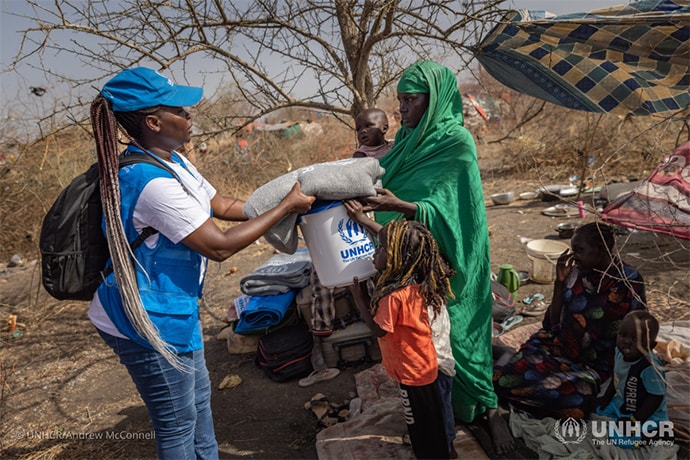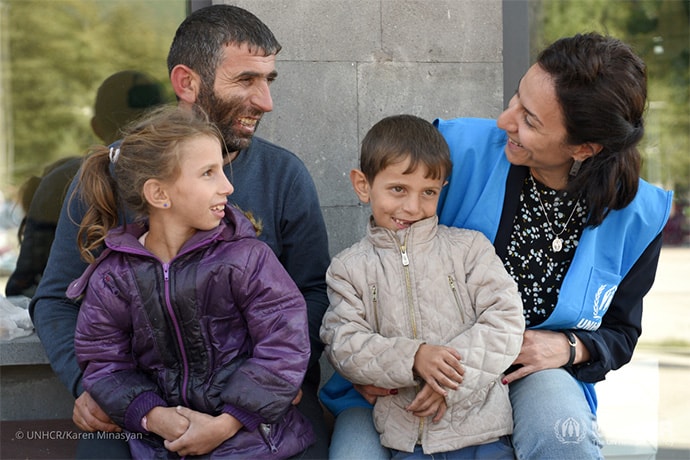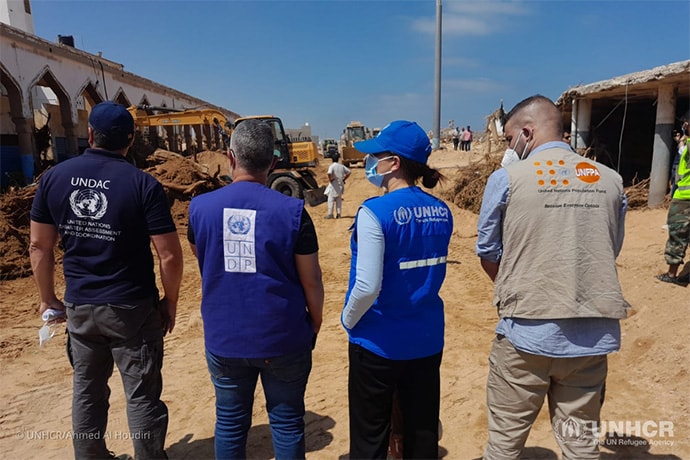Republished with permission from USA for UNHCR.
When a humanitarian emergency strikes, people are often forced to flee their homes and leave everything behind to make the dangerous journey to safety. During an emergency response, UNHCR, the UN Refugee Agency prioritizes saving lives and minimizing serious harm by meeting the most urgent humanitarian needs.
UNHCR provides emergency protection and assistance to keep people safe, including shelter, access to clean water, food, medical care and help to reunite families. Within the first 72 hours of an emergency, UNHCR can mobilize supplies for 1 million people and deploy expert staff to protect them.
How does UNHCR define an emergency?
UNHCR’s definition of an “emergency” is composed of two criteria. Firstly, there is a humanitarian crisis or disaster which either threatens to cause new forced displacement, loss of life or other serious harm, or which significantly affects the rights or well-being of refugees, internally displaced persons (IDPs), stateless persons, returnees and other persons of concern, unless immediate action is taken.
Secondly, for an “emergency” to be declared, the humanitarian crisis must demand exceptional measures because current government and UNHCR capacities are inadequate for a predictable and effective response. The declaration of an emergency level is based on a country operation’s analysis of the situation, as well as its existing preparedness and response capacity.
UNHCR may declare one of three emergency levels, based on the severity of the humanitarian crisis and the level of response required.
- A Level 1 emergency is declared when a country operation must enhance preparedness and/or commence an initial response, while the current capacity of the country operation is insufficient.
- A Level 2 emergency is declared in a rapidly evolving humanitarian situation when a country operation faces significant gaps in resources, staffing and expertise and additional support and resources from the regional bureau are vital for the operation to respond.
- A Level 3 emergency signifies an exceptionally serious situation in which the scale, pace, complexity and consequences of the crisis significantly exceed the existing response capacities of the country operation and regional bureau. This is the highest emergency level and activates a “whole-of-UNHCR” global response, in coordination with other UN agencies and partners.


What assistance does UNHCR provide to people in emergencies?
By September 2023, 114 million people globally were forcibly displaced from their homes. UNHCR assists millions of people in emergency situations every year, including 16.7 million people who received emergency supplies in 2023. UNHCR continually analyzes the risk of emergencies globally so that teams are prepared to respond quickly and effectively. When an emergency breaks:
- UNHCR delivers lifesaving relief items and other critical goods from its global stockpiles, ready in warehouses in strategic locations around the world.
- UNHCR deploys emergency response experts who are trained in crisis management and specialize in key areas like legal protection, cash assistance, shelter and tackling sexual exploitation.
- UNHCR transfers funds from emergency reserves directly to local UNHCR teams on the ground to set up shelters, buy food and register people who need help.
The most immediate need in a displacement crisis is often safe, suitable shelter. UNHCR delivers lifesaving tents, plastic sheeting and bedding so people exhausted from a long and often dangerous journey can sleep indoors, where they feel safer and are protected from harsh weather.
Furthermore, UNHCR helps find safe places for refugees to settle, and when there is no alternative, it will set up and help manage refugee camps in coordination with local governments.


How does UNHCR help to ensure that refugees reach safety during an emergency?
People forced to flee must not be expelled or returned to situations where their lives and freedom are at risk. Ensuring refugees can reach safety and are not pushed back across a border is central to UNHCR’s work.
When people are fleeing across a border, roving teams are out in vehicles in all kinds of terrain, sometimes 24 hours a day, to help ensure refugees can reach safety. UNHCR monitors whether governments and armed groups are preventing refugees from entering a safe area, and when necessary, advocates with authorities and alerts the media. UNHCR teams also try to ensure that people crossing a border have a realistic chance of having their refugee status recognized.
Staff on the ground register and document displaced people and identify the most vulnerable among them, such as older people, children traveling alone or pregnant women, to ensure they receive any specialized care they need.


How does UNHCR coordinate assistance during emergencies?
In an emergency, every second counts, so coordination is key to saving lives. With a presence in more than 130 countries, UNHCR works to bring everyone together to ensure the best possible response to those who have been displaced, including governments, other UN agencies, non-governmental organizations (NGOs) and local organizations. Working together ensures not only that immediate lifesaving aid is delivered but also protection, trauma counseling and health support needs are met.
When emergencies force people to flee across borders, UNHCR leads the overall refugee emergency response across all sectors and coordinates with partners and authorities. When people are displaced within their own country, UNHCR and other humanitarian partners activate the cluster approach, under which different organizations lead the coordination in specific areas of response, based on their expertise.
How did UNHCR respond to emergencies in 2023?
In 2023, UNHCR issued 43 emergency declarations in 29 countries – the highest number in decades – and deployed 339 emergency staff. From its seven global stockpiles, UNHCR delivered emergency supplies worth $53.5 million including 7.4 million relief items to serve up to 16.7 million people around the world.
Throughout the year, UNHCR responded to multiple crises globally, aiding millions affected by earthquakes in Syria, Türkiye and Afghanistan; a new conflict in Sudan and flare-ups of old conflicts in Karabakh and Somalia; a deteriorating crisis in the Democratic Republic of the Congo, unprecedented mixed movements of refugees and migrants in Latin America and the Caribbean, and floods in Libya and the Horn of Africa.